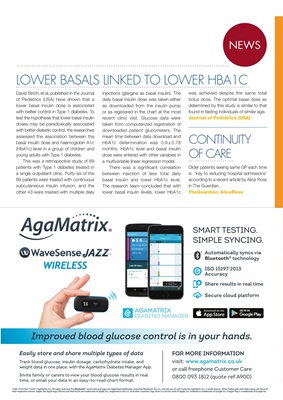
NEWS
LOWER BASALS LINKED TO LOWER HBA1C
injections (glargine as basal insulin). The
daily basal insulin dose was taken either
as downloaded from the insulin pump
or as registered in the chart at the most
recent clinic visit. Glucose data were
taken from computerized registration of
downloaded patient glucometers. The
mean time between data download and
HbA1c determination was 0.9 ± 0.78
months. HbA1c level and basal insulin
dose were entered with other variables in
a multivariable linear regression model.
There was a significant correlation
between injection of less total daily
basal insulin and lower HbA1c level.
The research team concluded that with
lower basal insulin levels, lower HbA1c
David Strich, et al, published in the Journal
of Pediatrics (USA) have shown that a
lower basal insulin dose is associated
with better control in Type 1 diabetes. To
test the hypothesis that lower basal insulin
doses may be paradoxically associated
with better diabetic control, the researches
assessed the association between the
basal insulin dose and haemoglobin A1c
(HbA1c) level in a group of children and
young adults with Type 1 diabetes.
This was a retrospective study of 89
patients with Type 1 diabetes treated in
a single outpatient clinic. Forty-six of the
89 patients were treated with continuous
subcutaneous insulin infusion, and the
other 43 were treated with multiple daily
was achieved despite the same total
bolus dose. The optimal basal dose as
determined by this study is similar to that
found in fasting individuals of similar age.
http://bit.ly/jpeds_lowerhba1c